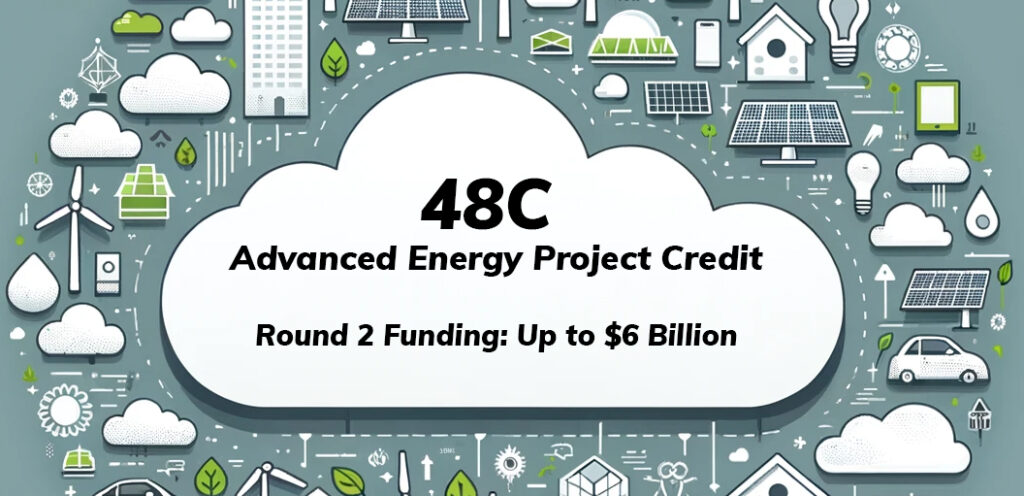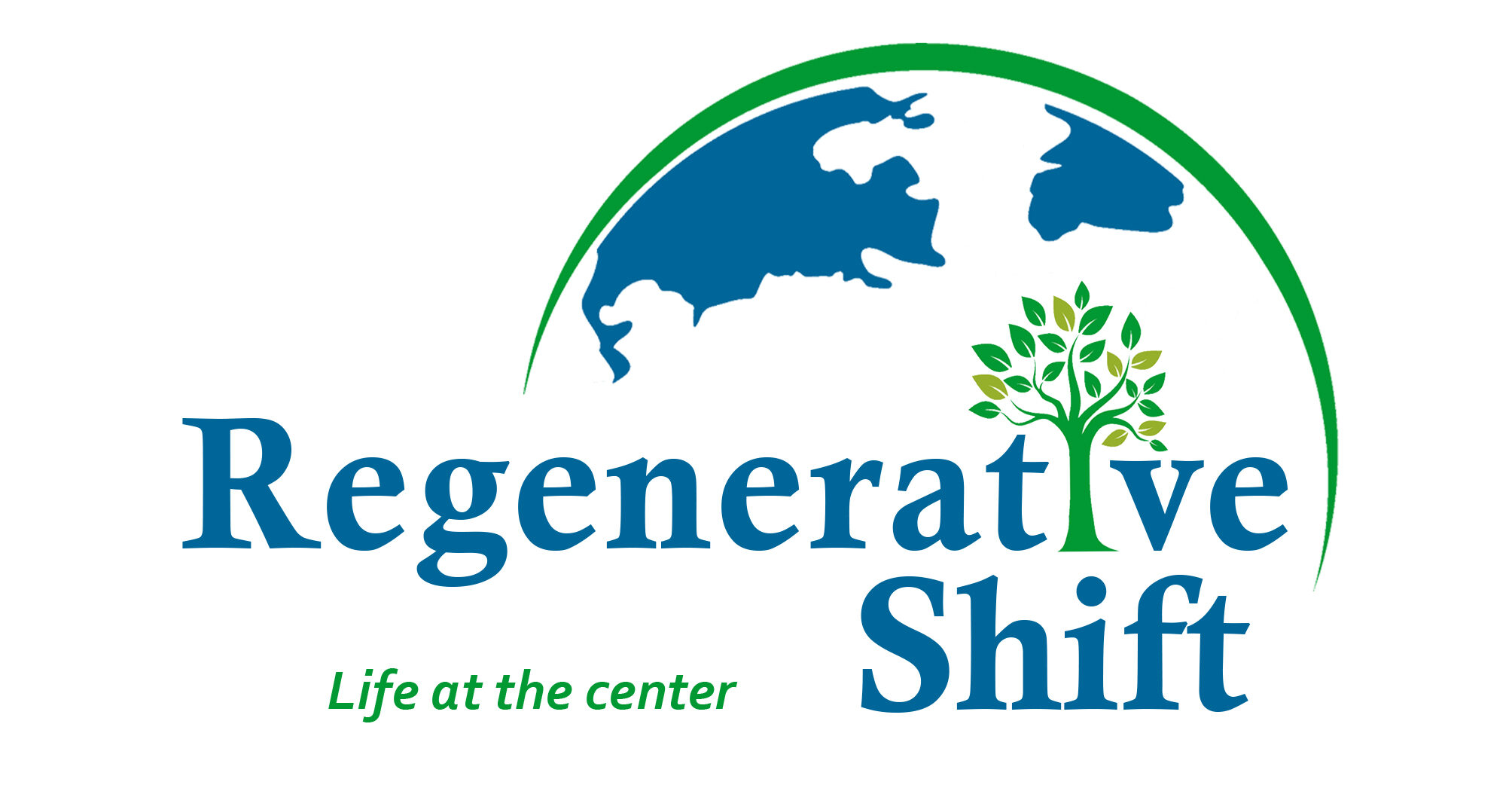
Note: this information is summarized from various publications from the Energy.gov and IRS.gov. For the DOE program page official information, click here.
48C Advanced Energy Project Round 2 Funding Summary
- Through the Inflation Reduction Act, the Department of Energy (DOE) funded $10 billion in tax credits to support domestic clean energy and industrial decarbonization projects.
- The tax credit is 30% of investment costs on projects that expand domestic clean energy manufacturing and projects for certain industrial manufacturers that reduce GHG emissions by at least 20%.
- Round 1 funding for $4 billion will be awarded by March 31, 2024, based on a highly competitive application process that began in Summer 2023.
- Round 2 funding will provide up to $6 billion in additional tax credits, with additional guidance expected in the Spring, possibly for a Fall 2024 application process.
- Round 2 is expected to be oversubscribed, meaning more applications than money available.
- The DOE has identified program goals, including prioritizing commercial viability, GHG emission reduction, strengthening US supply chains, and workforce and community engagement, particularly in Energy Communities and Disadvantaged Communities.
- Efforts to have align your project with DOE criteria will be critical to positioning your application for success.
- Key Consideration Areas:
- Domestic job creation: document how your project creates quality jobs, both during construction through prevailing wages and apprenticeships, and through long-term job creation.
- GHG emissions impact: document and prioritize measurable impact on GHG emissions through your project.
- Community Impact: prioritize meaningful compact engagement, including prioritizing support for surrounding Energy Communities and/or Disadvantaged Communities.
48C Advanced Energy Project Credit
Through the Inflation Reduction Act, the Department of Energy (DOE) funded $10 billion for the 48C Advantaged Energy Project Credit to support domestic clean energy and industrial decarbonization projects. A program aim is strengthening the US supply chain of clean energy products, including solar, wind, other renewable energy, energy storage, electric grid modernization, carbon capture, electric vehicles, clean fuels, and energy efficiency products. The program also provides incentive to support the decarbonization of the industrial manufacturing processes.
48C provides a 30% tax credit on eligible projects for tangible property, not including a building or its structural components. For many clean energy manufacturers considering expanding production, this 30% credit can help greenlight a major investment. 48C is subject to Prevailing Wage and Apprenticeship (PW&A) guidelines, and credit is reduced by 80% (30% goes down to 6%) if project does not meet PW&A requirements as noted in the Davis-Bacon Act.
48C Round 1 Funding: $4 Billion
48C has a competitive application process to be awarded the 30% tax credit, and has multiple stages of DOE review. First, projects must submit a Concept Paper that outlines in five pages the project details and impact. The DOE reviews the Concept Paper provides either an encouragement (that the project as outlined is likely to receive the credit) or a discouragement (that it is not). After this DOE review, projects may submit the full 30-page Application.
The rollout of the 48C credit began with Round 1 funding, allocating $4 billion to be awarded by March 31, 2024. The application process, which started in Summer 2023, set a highly competitive tone, reflecting the high stakes and significant interest in clean energy development.
In 48C Round 1, many projects received discouragement letters from the DOE. 48C was oversubscribed, meaning more projects applied than funds were available. Thus, projects that submitted projects that were not actively aligned with several DOE priority areas were discouraged from the full application process.
48C Round 2: Up to $6 Billion
With 48C Round 2, the DOE plans to distribute up to $6 billion in additional tax credits. This next phase, possibly to begin in Fall 2024 following additional guidance in the Spring, promises to again be oversubscribed, leading to a highly competitive selection process. Projects that were discouraged in Round 1 can apply again, with enhancements that strengthen your alignment with the DOE goals. Additionally, many new clean energy and industrial decarbonization projects will apply.
If you are seeking 48C funding in Round 2, strategic planning around the project can greatly improve the likelihood of receiving the 30% tax credit.
48C Program Goals: Navigating the Path to Approval
The DOE has outlined clear goals for the program, emphasizing not just the technological innovation and economic viability of projects but also their environmental and social impact. Key among these goals is the reduction of GHG emissions, a critical factor given the urgent need to address climate change. Additionally, the program seeks to strengthen U.S. supply chains, a move towards enhancing the resilience and self-reliance of the American economy in the clean energy sector.
Key Consideration Areas for Applicants
To navigate the competitive landscape of Round 2 funding, applicants must carefully address several key areas in their proposals:
Domestic Job Creation
The program places a high value on domestic job creation, urging applicants to document how their projects will contribute to employment opportunities. This includes detailing plans for construction jobs that pay prevailing wages and offer apprenticeships, as well as long-term positions that arise from the operational phase of the project. Demonstrating a clear pathway to substantial and sustainable job creation can significantly enhance an application’s appeal.
Commercial Viability
48C prioritizes projects that are commercially viable and will have high probability of achieving claims for clean energy production and/or GHG emissions reduction. It also prioritizes innovation, focusing on projects that will bring resilience to US supply chain of clean energy. Highlighting how your project is innovative and scalable, as well as is properly vetted to be successful will enhance your application.
GHG Emissions Impact
A project’s potential to reduce GHG emissions is another critical evaluation criterion. Applicants must provide detailed documentation and prioritization of their project’s measurable impact on emissions. Proposals that offer innovative solutions and substantial reductions in GHG output are more likely to stand out in the selection process.
Community Impact
The IRA also prioritizes projects that engage meaningfully with local communities, especially those designated as Energy Communities or Disadvantaged Communities. Applicants should outline how their projects will support these communities, whether through direct investment, job creation, or environmental improvements. Projects that demonstrate a tangible, positive impact on surrounding communities will be viewed favorably.
Positioning for Success in Round 2
Given the competitive nature of the funding process and the oversubscription anticipated for Round 2, positioning an application for success requires a strategic and comprehensive approach. Applicants should:
- Thoroughly align their projects with DOE criteria, ensuring that every aspect of the proposal reflects the program’s goals and priorities.
- Demonstrate a clear understanding of the community and environmental benefits of their project, beyond the immediate economic or technical advantages.
- Engage with stakeholders early and often, from local communities to industry partners, to build broad-based support for their projects.
- Stay informed on additional guidance from the DOE, adapting their strategies to meet evolving requirements and expectations.
Prevailing Wage and Apprenticeship Requirements
For 48C Advanced Energy Project Credit, 80% of the Section 48 Investment Tax Credit is tied to the project meeting the Prevailing Wage and Apprenticeship (PW&A) requirements. This means that laborers on the project must be paid a wage that matches or exceeds the requirements under the Davis-Bacon Act. Additionally, qualified apprentice labor needs to 15% of the total front line labor hours on the project.
If PW&A are not met and properly documented, the value of 48C credit is reduced from 30% to 6%. Alternatively, contractors that didn’t meet the PW&A guidelines on a project may pay back wages and in some cases penalties for the project to qualify for the higher 30% credit.
Next Steps
For organizations considering applying for the competitive 48C Advanced Energy Project Credit in Round 2, begin preparing your project now. Work with a trusted advisor to navigate the nuances of DOE priority areas, concept papers, applications, GHG emissions calculations, energy modeling, prevailing wage and apprenticeship requirements. If you’d like to explore with Regenerative Shift, Contact Us!
_____________________________________________________________________________________________________________
About the Author
Caleb Quaid is the founder of Regenerative Shift, a Tampa-based environmental consulting firm, working with businesses and communities on regenerative environmental initiatives and sustainability programs. Regenerative Shift focuses on life-creating and cost-saving holistic programs, including regenerative land and water projects and Inflation Reduction Act (IRA) consulting. As a consultant and public speaker, Caleb provides motivating insight into practical life-creating environmental practices and shows the business case for going green with tax incentives under the IRA.
Now what?
The IRA can be a lot to navigate, and new guidance is issued every week. If you’d like to discuss how your business can benefit, Regenerative Shift is here to help! Contact Us!
